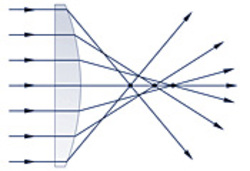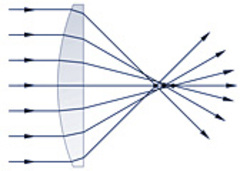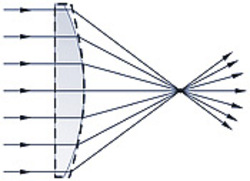Optical aberrations and image quality
In general, optical systems do not exhibit perfect properties. Optical components (e.g. lenses) exhibit so-called aberrations. A distinction is made between a large number of different types due to a wide variety of errors. The most important of these are: spherical aberration (errors caused by spherical surfaces), astigmatism (errors caused by toric lenses (cylindrical lenses)), chromatic aberrations (different refractive power at different wavelengths) and coma (errors caused by tilting of the lens). Due to the restriction to small field angles of +/- 2° described at the beginning of the chapter on image quality, only spherical aberration and astigmatism need to be taken into account in the field of high-resolution ophthalmic optics.
Chromatic aberration
Although the natural eye as well as artificial intraocular lenses (IOL) exhibit significant chromatic aberrations (different refraction of different wavelengths or colors), these do not need to be taken into account, as the color receptors of the retina and the subsequent neuronal image processing of the brain use them to extend the depth of field. Accordingly, there is no significant deterioration in visual acuity due to chromatic aberration [Charman96].
Astigmatism
Astigmatism, on the other hand, produces aberrations that can be corrected using toric lenses, which are also commonly used in spectacle optics. However, this requires a manufacturing process that is individually adapted to the patient. For cost reasons, however, this technology has not yet been widely used in the field of intraocular lenses.
Spherical aberration
Optical lenses made of glass or plastic are usually manufactured with spherical surfaces (cut from a sphere). The reason for this is that spherical surfaces are much easier to manufacture than non-spherical surfaces (so-called aspheres), which is why until a few years ago almost all lenses were manufactured with spherical surfaces. In the last ten years, however, new processes have been developed which make the production of aspherical surfaces possible in many areas of optics. Nevertheless, the vast majority of IOLs manufactured today are still based on spherical surfaces.

However, this form of surface curvature is not the ideal shape for focusing light and exhibits spherical aberrations. Depending on the focal length (or refractive index) of the lens, these lead to a sometimes considerable deterioration in the imaging properties. The imaging errors of spherical lenses can be largely neglected as long as the F-number (aperture diameter D divided by the focal length f) is small. The reason for this is the paraxial approximation, in which the sine/tangent of an angle for small angles can be approximated with the angle itself, resulting in an approximately linear behavior. However, this approximation only applies to beams close to the axis (paraxial beams). As the aperture increases, the rays from the outer regions are therefore refracted more than necessary in order to hit the same focus as rays close to the optical axis [Hecht98]. The adjacent diagram clearly shows this effect for a lens with a plane and a spherical surface (so-called plano-convex lens), whereby the plane side (front side) has no influence on the imaging quality in this case, as all rays strike vertically and are therefore not refracted. It can be seen that rays from different zones at different distances from the optical axis have different focal points. The stronger the spherical aberration, the poorer the image quality or MTF.

In the case of asymmetrical spherical lenses (i.e. lenses with two different radii of curvature of the two optically effective surfaces), the imaging quality is also crucially dependent on the orientation of the lens. An optimal design with spherical surfaces distributes the effective refractive power evenly over both boundary surfaces. Compared to the previously shown orientation of the plano-convex lens, in which the spherical surface contributes to the total refractive power, the diagram opposite shows a significantly better focusing, as the flat surface now also contributes part of the refractive power. In the optimum case, the flat surface here is also slightly curved and corresponding lenses are referred to as lenses with the best shape.
Symmetrical spherical lenses therefore show a slightly reduced image quality compared to asymmetrical lenses of the best shape. The disadvantage, however, is that when using asymmetrical lenses, especially in ophthalmology, care must always be taken to ensure correct orientation, otherwise the imaging properties will deteriorate significantly.

The use of aspherical lenses brings a considerable improvement in imaging properties. These adapt the curvature of the surface in the peripheral areas in such a way that spherical aberrations are largely or completely avoided. The diagram opposite shows this effect.
With the development of new manufacturing methods, such as high-precision diamond lathes, highly optimized aspherical surfaces for IOLs can be produced. The only disadvantage of these lenses to date is their significantly higher price.
Contact
Prof. Dr. rer.nat. Wilhelm Stork,
Tel. 0721 / 608 - 2510, wilhelm.stork∂kit.edu

